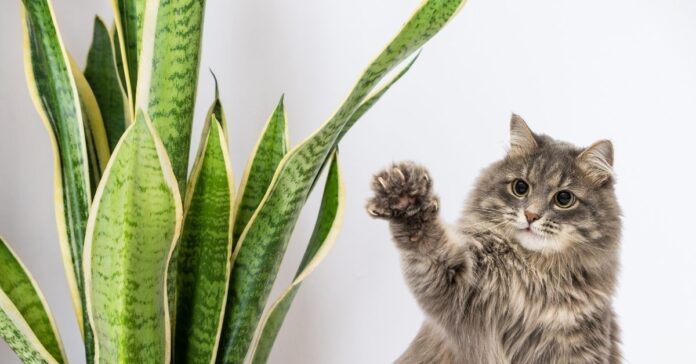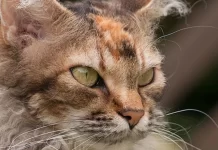Last Updated on September 16, 2023 by Fumipets
The question of whether snake plants (Sansevieria) are toxic to cats is a common concern for pet owners. Snake plants, known for their air-purifying properties and easy care, can add a touch of greenery to your home. However, it’s crucial to understand the potential risks they may pose to your feline companions.
Snake plants contain toxic compounds called saponins. These substances can cause gastrointestinal discomfort, including nausea, vomiting, and diarrhea, if ingested by cats. The severity of these symptoms can vary depending on the cat’s size, the amount consumed, and their individual sensitivity to toxins.
Are Snake Plants Toxic to Cats?
Due to their hardiness and simple maintenance requirements, snake plants are popular indoor plants. However, are snake plants toxic to cats. They have a saponin-type of poison in them. Many plants employ saponin as a defense mechanism to safeguard themselves against insects, bacteria, and fungus.
Not everything is lost if you already own a snake plant. You may attempt a few methods to stop your cats from consuming it. You may buy many more lovely cat-friendly houseplants to beautify your home as well.
Everything you need to know about snake plants and other common plants that are poisonous to cats is provided here. To help you with your home design inspiration, we’ve also supplied a list of cat-friendly houseplants.
What Happens If My Cat Ingests a Snake Plant?
The saponins are released when a snake plant leaf splits. Cats that eat the plant will first taste the bitter taste of the poison.
Afterwards, if cats consume the plant, they may suffer a number of side effects:
Nausea
Vomiting
Diarrhea
Depression
Abdominal discomfort or pain
Drooling
Loss of appetite
Swollen mouth and throat
Cats with chronic ailments or illnesses run the risk of developing symptoms that are more severe.
Cats would probably only eat a small portion of a snake plant leaf or possibly spit it out due to its harsh flavor. Fortunately, cats don’t die if they consume a modest amount of saponin. As a result, it’s possible that your cat may exhibit symptoms for a day or two.
If you think your cat may have swallowed a large portion of a snake plant leaf or if you see any serious symptoms or allergic responses, such as swelling or itching, you should call your veterinarian straight once.
Your cat’s stomach and GI system may be soothed with medicine prescribed by your veterinarian, who can also diagnose the problem and prescribe antihistamines for allergies.

How to Stop Cats from Eating Snake Plants
You might attempt various techniques to prevent your cats from playing with or eating a snake plant.
You may attempt these techniques, but bear in mind that there is no way to ensure your cat won’t consume a poisonous plant. If your cat repeatedly attempts to devour these kinds of plants, it is thus better to get rid of them from your house.
1. Relocate the Plant
Ideally, you should keep the plant distant from your cat’s dining area, furnishings, and litter boxes.
The room with a door you can lock is one of the safest locations for the plant so you won’t have to worry about your cats when you can’t keep an eye on them. Fortunately, snake plants may thrive in spaces with less natural light since they don’t need a lot of sunshine.
2. Place the Plant on a Stand
To make it harder for your cat to get to the plant, you may also try putting it on a shelf or a plant stand. Finding a plant stand that blends in with the rest of your furniture shouldn’t be too difficult since there are so many different types of plant stand designs.
3. Make the Plant Smell Bad
By surrounding the snake plant with odors that are often repulsive to cats, you may attempt to deter your cat from it. You may use the juice or zest of lemons, limes, or oranges to deter cats from visiting the plant since most cats don’t enjoy the aroma of citrus fruits.
You may try spreading cinnamon or cayenne pepper on the ground as cats don’t appreciate either of those flavors.
4. Spray Plant Leaves with Pet Spray
There are a variety of plant sprays available on the market that function to deter dogs from chewing on certain objects. Most tastes are citrus or bitter apple. Just bear in mind that cats have diverse tastes, so certain sprays they may tolerate while finding others repulsive. As a result, it could take a few trials before you discover a spray that efficiently keeps your cat away from pests.
Additionally, you need to locate a spray that won’t harm the leaves of your plant. To begin, spray only one section of the plant to observe whether it damages it. Spray the plant’s leaves at the manufacturer’s suggested frequency once you’ve found a spray that works.
You may alternatively spritz the leaves with a mixture of one part vinegar and three parts water.
5. Cat Grass
If your cat just likes to chew on leaves, you may want to try switching its attention to cat grass. Cat grass is quite simple to maintain and cultivate. It may be a nutritious treat for your kitties since it also includes minerals and fiber.
Common Houseplants That Are Toxic to Cats
Houseplants give interior rooms a cozy, energetic feel. Many popular types, meanwhile, are poisonous to cats. The following common houseplants are not recommended for cat owners. Just keep in mind that this is not an entire list, so before bringing a plant home, be sure to check to see whether it is non-toxic.
1. Aloe Vera
The aloe vera plant has a number of health advantages for people. Cats, however, cannot consume this plant. Anthraquinones and saponins are present.
Symptoms that cats that consume this plant may suffer include:
Vomiting
Lethargy
Diarrhea

2. Jade
There are various names for these plants:
Rubber plants
Money plants
Lucky plants
Cats are poisoned by all jade plants. If you think a cat may have eaten a jade plant leaf, while its exact poisonous ingredients are yet unclear.
Symptoms that cats that consume this plant may suffer include:
Vomiting
Depression
Incoordination
3. Monstera Deliciosa
A variety of philodendrons called monstera deliciosa are sold by various stores under a variety of interchangeable names, including:
Hurricane plant
Swiss cheese plant
Ceriman
Mexican breadfruit
Split-leaf philodendron
Window leaf plant
These plant’s toxic substances are insoluble calcium oxalates. Symptoms that cats that consume this plant may suffer include:
Oral irritation
Intense burning on mouth, tongue, and lips
Drooling
Vomiting
Difficulty swallowing
4. Peace Lilies
Insoluble calcium oxalates are another ingredient in peace lilies. Cats will therefore manifest the same symptoms as cats who consume monstera deliciosa:
Oral irritation
Intense burning on mouth, tongue, and lips
Drooling
Vomiting
Difficulty swallowing
5. Pothos
Pothos are climbing plants with several other names, including:
Devil’s ivy
Taro vine
Ivy arum
Pothos contains insoluble calcium oxalates as do monstera deliciosa and peace lilies, and it will result in comparable symptoms:
Oral irritation
Intense burning on mouth, tongue, and lips
Drooling
Vomiting
Difficulty swallowing
Common Houseplants That Are Safe for Cats
There are numerous safe and non-toxic houseplants that you may readily find, despite the fact that some common ones are hazardous to cats.
1. Peperomia Obtusifolia
This plant takes little care and attention and needs little attention. “Baby rubber plant” is another name for it. They will produce gorgeous white blooms throughout the seasons with a little tender attention and care.
2. Birds Nest Fern
Squiggly plants called birds nest ferns provide a playful element to any space. Because they thrive in damp situations and can survive in low-light settings, they are relatively low-maintenance and can even thrive in restrooms.
3. Money Tree
There are different sizes of money trees, and they supposedly bring good fortune to the house. These trees often have stylish braided patterns, making them popular as standout elements for a space.
4. Parlor Palm
Hardy plants, parlor palms flourish in areas with direct sunshine. They may grow above 6 feet once they settle in a space and continue to develop.
5. Pilea Peperomioides
Several names for these interesting plants exist:
Chinese money plant
UFO plant
Pancake plant
Missionary plant
The only need for this plant’s upkeep is that it prefers direct sunshine. Many people see this plant as a fortunate charm that brings luck to its owner in addition to its unusual look.

Conclusion
Some plants just don’t thrive in homes with cats, especially if the felines are highly curious. If you currently have a houseplant that is poisonous to cats, there are a few things you can do to prevent accidents where cats inadvertently swallow them.
Never hesitate to call your veterinarian if you have any reason to believe that your cat has consumed a poisonous plant. Better safe than sorry
Buying plants that are safe for cats to consume is the finest and safest method to have plants in your house. Thankfully, there are a ton of attractive indoor plants that cats may safely enjoy.
Therefore, don’t be reluctant to use your imagination. In little time at all, you’ll have a joyful and peaceful house with lovely plants and kitties.
Questions and Answers About Snake Plants and Cats:
Are all parts of the snake plant toxic to cats?
Yes, all parts of the snake plant, including the leaves, stems, and roots, contain saponins and are considered toxic to cats if ingested.
How can I protect my cat from snake plant toxicity?
To protect your cat, consider placing snake plants in areas that are inaccessible to them, such as high shelves or rooms your cat doesn’t frequent. You can also use deterrents like bitter sprays to discourage chewing.
What are the signs of snake plant poisoning in cats?
If your cat has ingested snake plant leaves or parts, watch for signs of poisoning, which may include vomiting, diarrhea, drooling, lethargy, or changes in behavior. If you suspect poisoning, contact your veterinarian immediately.
Can snake plants be kept in a cat-friendly home?
Yes, it’s possible to keep snake plants in a cat-friendly environment. By taking precautions, like placing them out of reach and monitoring your cat’s behavior, you can enjoy the benefits of snake plants without putting your pet at risk.
Are there non-toxic alternatives to snake plants for cat-friendly homes?
If you’re concerned about the potential risks of snake plants, consider other non-toxic indoor plants like spider plants, Boston ferns, or cat grass. These can provide greenery in your home without posing a threat to your feline friend.


















